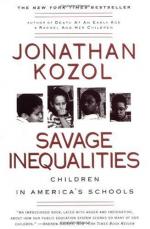|
This section contains 1,185 words (approx. 3 pages at 400 words per page) |

|
Chapter 5, "The Equality of Innocence: Washington, D.C.," Summary and Analysis
Kozol complains that discussions about educational problems seem to ask for almost equal treatment, but never identical treatment for the poor. He actually points out a case where the state comes out and says 100 percent equity isn't possible. Maybe 75 percent is possible.
John Coons of Berkeley University says all children are technically "poor" because they depend on someone else to give them money. Most people are uncomfortable today saying dark people deserve less because their parents aren't worth as much, but the treatment of non-white children shows this is accepted, just not admitted. Kozol says the white and wealthy seem to think they deserve their success and should be the ones to decide if the poor and non-whites get anything. This attitude allows the luckier...
(read more from the Chapter 5, "The Equality of Innocence: Washington, D.C.," Summary)
|
This section contains 1,185 words (approx. 3 pages at 400 words per page) |

|




